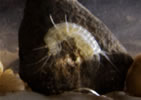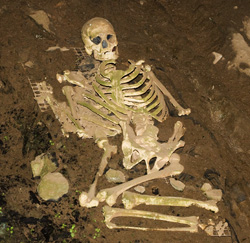Most of the caves on the Mendips are formed in Carboniferous limestone. The Carboniferous Period stretched from 345 to 280 million years ago (mya) and is split into the Lower (345 to 310 mya) and Upper Carboniferous (310 to 280 mya). The Mendip limestone was deposited during the Lower Carboniferous, a period of shallow, warm seas in which corals, brachiopods, crinoids, blastoids, bryozoans and foraminifera flourished, hence the limestone is rich in fossil deposits.
SEALIFE FOSSILS of the CARBONIFEROUS LIMESTONE
Corals were abundant and diverse in Carboniferous seas and included both colonial and solitary forms.
Typical Lower Carboniferous taxa include: Dibunophyllum, Caninia, Zaphrentis and Cleistopora.
Brachiopods (lamp shells) have two unequal shells, each symmetrical about the midline and they lived attached to the seafloor by a stalk - the pedicle. Their fossils are most commonly seen in the Mendip caves in cross-section, appearing like pale ellipses and semicircles. Seminula was a common genus in Lower Carboniferous seas.
Crinoids (sea lilies) consisted of a segmented stem with a crown of feathery arms on top. When the animal died it disintegrated into the individual segments (ossicles) or into short lengths of stem consisting of a few connected ossicles. Often, this debris drifted to accumulate as thick beds to form crinoidal limestones. The fossil ossicles appear in cross section as circles, ellipses and rectangles depending on the angle of the section. If a length of stem is found the joints between the ossicles can be seen. Beds of crinoid fossils are very distinct in several Mendip caves, especially Tyning’s Barrows Swallet.
The Blastoids were an extinct form of echinoderm, distantly related to the crinoids and modern sea urchins and are especially common in Lower Carboniferous rocks. The fossils consist of a small (1 to 3cm) cup-like, plated body holding the animal itself and a short stem attaching the body to the sea bed.
Bryozoans (moss animals) are aquatic, colonial animals, whose colonies exhibit encrusting, branching or fan-like growth. Modern species still exist today in both fresh and marine waters.
The Foraminifera are microscopic Protozoa. The single-celled organism is contained in a test (shell) made from cemented foreign particles or lime. They were very abundant in ancient times and species still exist today. They are sometimes so abundant that their tiny shells cover thousands of square miles of ocean floor and form great deposits of ooze. Chalk is generally made up of fossilised Foraminifera deposits.
QUATERNARY FOSSIL MAMMALS AND ARCHAEOLOGY
The Quaternary period spans the last 2 million years of earth history when the climate cooled, culminating in the ice ages of the Middle to Late Quaternary with ice sheets repeatedly covering much of Britain. Over the last 500,000 years Britain has experienced 5 full glacial cycles from warm (peak interglacial) to glacial and back to peak interglacial conditions. For most of each cycle, the climate was cool with steppe or tundra conditions, rather than the extremes of either peak interglacials (closed deciduous woodland) or full glacials (ice sheets with polar deserts to the south). We live in an interglacial period now - the Holocene.
At several sites on the Mendips (e.g. Hyaena Den near Wookey Hole), large carnivores including hyaenas and bears used to live in caves in the past, with hyaenas denning in the cave and bears using it for hibernation and winter breeding. Caves were also sometimes used by Palaeolithic man. At that time (~60,000-10,000 yrs BP), other creatures roaming about outside included horse, bison, reindeer, woolly rhino, and woolly mammoth: most of the bones of these species found in caves were brought in by hyaenas. Evidence shows that Britain was fairly uninhabited during the coldest part of the ice age (26,000-13,000 yrs BP). During the last glaciation, the Mendips, in common with the rest of southern England, lay to the south of the ice sheets and conditions of arctic tundra existed here.
Cave entrances acted as sediment traps through the Quaternary period and preserved the bones of the animals living in the area. As mentioned above, the Mendips lay south of the glacial limit and was one of a few limestone areas to escape glaciation. Consequently it has a particularly good record of Quaternary fossil mammals and archaeology as no erosion by ice sheets has occurred. Bone deposits accumulated principally as a result of two mechanisms: shafts which acted as pitfall traps, and hyaena dens. Human use of caves dates mainly from the Late Quaternary period, with Middle Palaeolithic Neanderthal hunters using caves from about 60,000 years BP, replaced by early modern human Late Palaeolithic man around 35,000 years BP.
The Mendips include many sites notable for their Quaternary and archaeological finds, the most important of which are detailed below.
Gough’s Cave: one of Europe’s most important Upper Palaeolithic archaeological sites. This is the site where the 9000 year old “Cheddar Man” was discovered along with many other important artefacts.
|
Replica of Cheddar Man, Gough's Show Cave |
Banwell Bone Cave: Vast numbers of animal bones have been found here mostly of bison and reindeer but also brown bear, wolverine and arctic fox. This uniquely rich Pleistocene bone assemblage dates from the early part of the last glaciation, approximately 80,000 years ago. It was probably a pitfall trap with the material being added to gradually, probably by flooding. Unusually there are wolf bones but no evidence of hyena.
Westbury Quarry: blasting in 1969 discovered a massive sediment-filled cave that was excavated by the Natural History Museum in the 1970s. The sediment was layed down in a Middle Palaeolithic interglacial (about 620,000 years ago) and contained the remains of small mammals and in places the cave and brown bear. This is the earliest mammalian cave fauna established for Mendip.
Read’s cavern: once lived in by early Iron Age people, whose remains were found during an archaeological dig, buried beneath a rock-fall.
Aveline’s Hole: A very important archaeological site, including the earliest dated human cemetery in Britain from the Mesolithic (about 8,400 years old) and also one of the few examples of cave art in Britain.
Wookey Hole: Numerous mammal bones have been found in Wookey Hole and the caves in the gorge outside, along with important archaeological finds and a Romano-British cemetery.
Hyena Den: the cave had been used as a
den by spotted hyaenas who had accumulated large
numbers of heavily gnawed remains of their prey,
most notably those of the woolly rhinoceros. Like
many British hyaena dens this site proved to represent
the Middle Devensian, when the British
mammal fauna was dominated by mammoth, woolly
rhinoceros and horse.
Bleadon Cavern: this lion den in which cubs were
raised has an abundance of horse and wild boar
bones (an otherwise rare animal in the British Pleistocene
record). Other bones include elephant, rhino and mammoth.
Some of the finds from the Mendip caves can be seen on display at the Wookey Hole and Cheddar show caves, Axbridge Museum, Wells Museum, Taunton Museum and the Natural History Museum in London.
|


